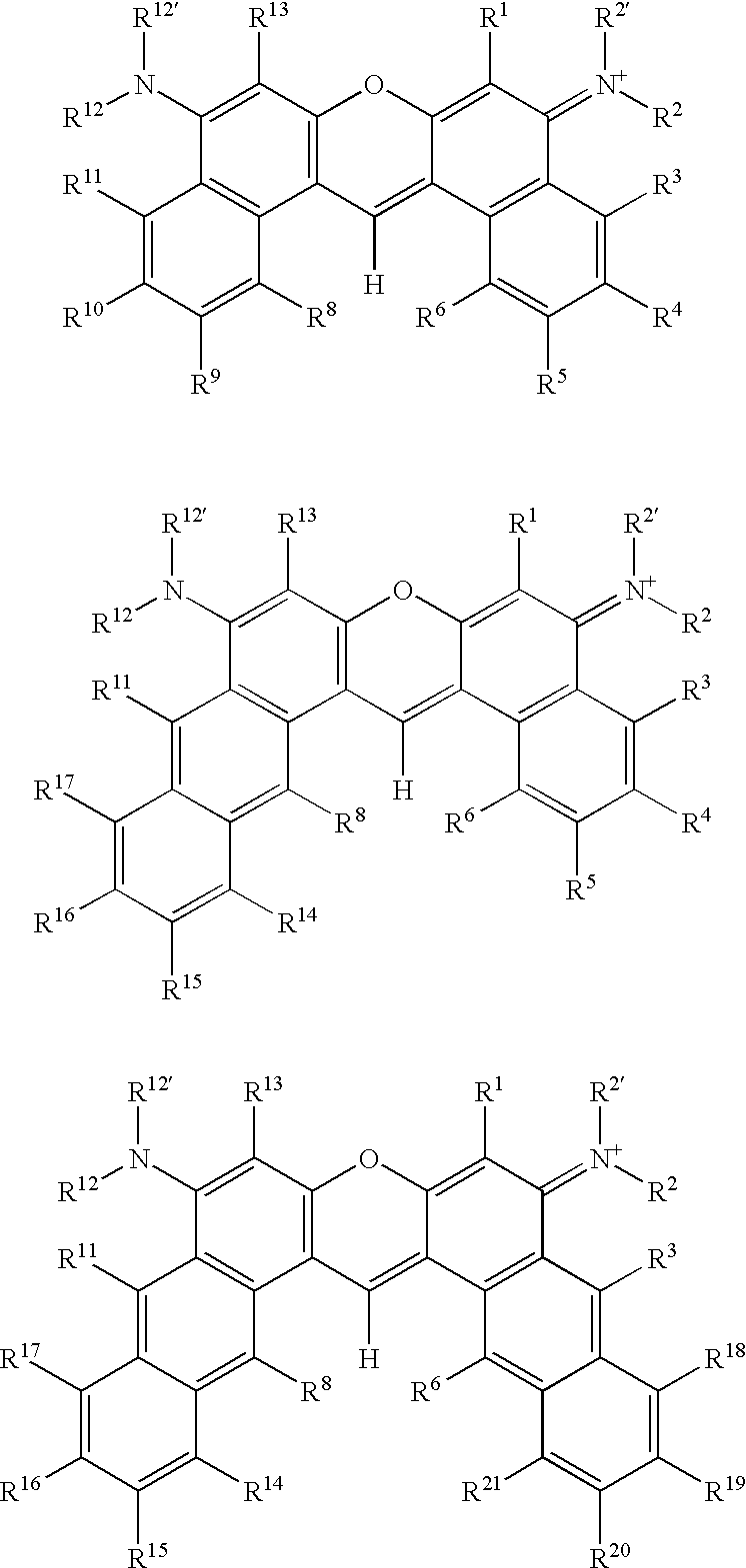Sulfonated diarylrhodamine dyes
a diarylrhodamine and sulfonated technology, applied in diaryl/triaryl methane dyes, anthracene dyes, peptides, etc., can solve the problems of difficult to find a set of structurally similar dyes whose emission spectra are spectrally resolved, and the set may still not be suitabl
- Summary
- Abstract
- Description
- Claims
- Application Information
AI Technical Summary
Benefits of technology
Problems solved by technology
Method used
Image
Examples
example 1
Synthesis of 1-Diethylamino-3-Hydroxynaphthalene 4 (FIG. 1)
3-Methoxy-1-hydroxynaphthalene 1 (1 gm), synthesized from 1,3-dihydroxynaphthalene by the method of K. H. Bell and L. F. McCaffery (1993), Aust. J. Chem. 46:731, was suspended in dry CH.sub.2 Cl.sub.2 (30 ml). Dry triethylamine (1.2 equivalents) was added and the reaction was cooled to -5.degree. C. Trifluoromethanesulfonic anhydride (1.1 equivalents) suspended in CH.sub.2 Cl.sub.2 (15 ml) was added dropwise with vigorous stirring over a period of 2 hours. The reaction was allowed to come to room temperature and subjected to aqueous work up using 5% HCl and CH.sub.2 Cl.sub.2. The resulting crude 3-methoxynaphthalene-1-triflate 2 was purified by normal phase flash chromatography employing an EtOAc / Hexane (1:10) mobile phase.
The purified 3-methoxynaphthalene-1-triflate 2 was converted to the 1-diethylamino-3-methoxynaphthalene 3 using the palladium-catalyzed triflate / amine coupling procedure of J. P. Wolfe and S. L. Buchwald (...
example 2
Synthesis of N-Phenyl-3,3-Dimethyl-Hydroxy-Benzoindoline 9 (FIG. 1)
The 3-methoxynaphthalene-1-triflate 2 was derivatized with aniline according to the palladium catalyzed triflate / amine coupling reaction described above in Example 1 to give the 1-anilino-3-methoxynaphthalene 5.
The 1-anilino-3-methoxynaphthalene 5 was acetylated by an amino group acetylation procedure as follows. The 1-amino-3-methoxynaphthalene 5 (500 mg) and 1.2 equivalents of dry Et.sub.3 N were suspended in 10 ml of dry CH.sub.2 Cl.sub.2 and cooled to -5.degree. C. using an ice / NaCl bath. 1.1 equivalent of 2-bromo-2-methylpropionylchloride was added dropwise and the reaction was stirred for 1 hour at -5.degree. C. and stirred at room temperature for an additional 1 hour. The reaction was allowed to come to room temperature and subjected to aqueous work up using 5% HCl and ethylacetate resulting in the crude intermediate 1-(bromoalkyl)amido-3-methoxy-naphthalene 6, which was purified by normal phase flash chromato...
example 3
Synthesis of N-Methyl-5-Hydroxy-(Tetrahydro)benzoquinoline 15 (FIG. 2)
Compound 10 was synthesized by condensation of methoxy-naphthaldehyde and malonic acid employing piperidine catalysis in pyridine. Compound 10 was reduced with hydrogen over 10% Pd / carbon, followed by LAH reduction, and reacted as outlined for the synthesis of compound 2 above with trifluoromethanesulfonic anhydride to give the triflate 11. Triflate 11 was then reacted with NaN.sub.3 (3 equiv.) in DMF at 100.degree. C. for 6 hours. Then, the reaction was allowed to come to room temperature and subjected to aqueous work up using pure water and EtOAc resulting in pure compound 12. Compound 12 was suspended in dry CH.sub.2 Cl.sub.2, complexed with 3 to 5 equivalents of solid AlCl.sub.3, and refluxed for 2 hours yielding compound 13.
Compound 13 was alkylated with MeI according to a general amino group alkylation procedure as follows. The 3-methoxybenzoquinoline derivative (100 mg) 13 was suspended in 5 ml of dry THF a...
PUM
| Property | Measurement | Unit |
|---|---|---|
| Structure | aaaaa | aaaaa |
| Solubility (mass) | aaaaa | aaaaa |
| Solubilizing | aaaaa | aaaaa |
Abstract
Description
Claims
Application Information
 Login to View More
Login to View More - R&D
- Intellectual Property
- Life Sciences
- Materials
- Tech Scout
- Unparalleled Data Quality
- Higher Quality Content
- 60% Fewer Hallucinations
Browse by: Latest US Patents, China's latest patents, Technical Efficacy Thesaurus, Application Domain, Technology Topic, Popular Technical Reports.
© 2025 PatSnap. All rights reserved.Legal|Privacy policy|Modern Slavery Act Transparency Statement|Sitemap|About US| Contact US: help@patsnap.com



